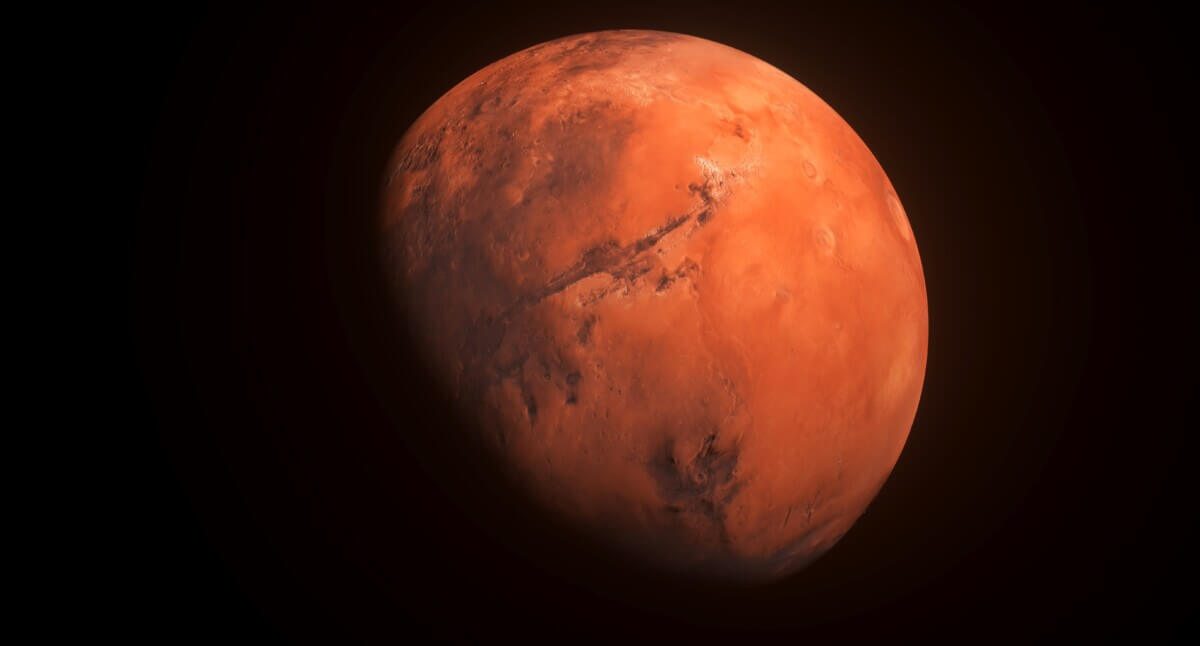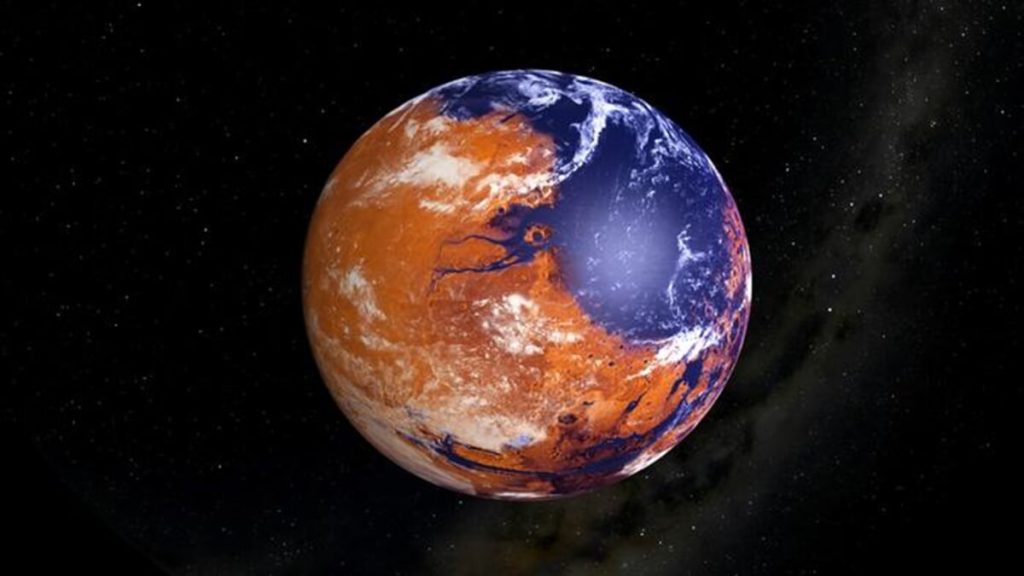

This is an artist’s concept of an early Mars with liquid water (blue areas) on its surface. Ancient regions on Mars bear signs of abundant water – such as features resembling valleys and deltas, and minerals that only form in the presence of liquid water. (Credit: NASA/MAVEN/The Lunar and Planetary Institute)
In a nutshell
- Mars’ missing atmosphere may not have escaped to space as previously thought. Instead, it likely underwent a chemical transformation and became trapped as methane within the planet’s clay minerals
- Over about a billion years, water trickling through Mars’ rocks triggered reactions that converted atmospheric carbon dioxide into methane, while simultaneously creating the red iron oxides that give Mars its distinctive color
- The clay minerals could store up to 1.7 times the pressure of Earth’s current atmosphere worth of carbon, potentially providing a resource for future Mars missions and helping explain how rocky planets evolve over time
CAMBRIDGE, Mass. — Three and a half billion years ago, Mars underwent a dramatic transformation. Its thick blanket of air thinned to almost nothing, its water disappeared, and the once-habitable world became a frozen desert. Now, MIT researchers have proposed an unexpected solution to this longstanding planetary mystery. The missing pieces of Mars’ atmosphere may be trapped within its clay minerals.
Early Mars had between 0.25 to 4 times the pressure of Earth’s current atmosphere at sea level. Today, Mars’ atmosphere is less than one-tenth as thick, a dramatic decrease that transformed the planet from a potentially habitable world to the frigid desert we observe now.
This transformation has been one of the biggest mysteries in planetary science, as none of the previous explanations fully accounted for where all that carbon went. In the study published in Science Advances, Joshua Murray and Oliver Jagoutz suggest that much of Mars’ missing carbon dioxide may be locked away as methane and organic carbon compounds stored within clay minerals in the Martian crust.
The path to this discovery began with Earth, not Mars. In 2023, Murray and Jagoutz were studying a type of clay mineral called smectite on Earth, known for its remarkable ability to trap carbon. These clay minerals contain countless microscopic folds where carbon can remain undisturbed for billions of years. The researchers found that on Earth, these clays helped cool the planet over millions of years by drawing carbon dioxide from the atmosphere. When Jagoutz later examined a map of Mars’ surface, he noticed something striking. Much of the Red Planet’s surface was covered in these same carbon-trapping clays.


Courtesy of Joshua Murray, Oliver Jagoutz, et al)
The formation of these clays on Mars reveals key differences between the two planets. On Earth, similar clays form through tectonic activity, the constant movement of continental plates that brings rocks from deep within the planet to the surface. Mars lacks this tectonic activity, so its clays must have formed through a different process. This difference led the researchers to investigate alternative formation mechanisms specific to Mars’ geology.
Through remote measurements, scientists have discovered that parts of Mars’ crust contain ultramafic igneous rocks, similar to those that produce smectites through weathering on Earth. Satellite observations have also revealed patterns resembling ancient rivers and tributaries, suggesting areas where water could have flowed and reacted with the underlying rock.
The process began with water trickling through rocks rich in a mineral called olivine. When oxygen from the water bound with iron in the olivine, it released hydrogen and formed oxidized iron, giving Mars its iconic red color. The freed hydrogen then combined with carbon dioxide in the water to form methane, which became trapped in the clay minerals. This complex chain of chemical reactions continued for roughly a billion years, slowly transforming Mars’ thick atmosphere into stored carbon within its crust.
“At this time in Mars’ history, we think CO2 is everywhere, in every nook and cranny, and water percolating through the rocks is full of CO2 too,” says lead study author Murray, in a statement.


Over about a billion years, this slow chemical reaction transformed olivine into serpentine, another type of iron-rich rock. Serpentine then continued to react with water to form smectite clays.
The team’s calculations suggest this process could account for a significant portion of Mars’ missing carbon dioxide. Murray and Jagoutz found that if Mars is covered in a layer of smectite 1,100 meters deep, these clays could store enough organic carbon—formed through processes that include methane production—to account for most of the carbon dioxide that disappeared from the atmosphere when the planet dried up. The stored carbon could potentially serve as a resource for future missions.
“Based on our findings on Earth, we show that similar processes likely operated on Mars and that copious amounts of atmospheric CO2 could have transformed to methane and been sequestered in clays,” says study author Jagoutz. “This methane could still be present and maybe even used as an energy source on Mars in the future.”
Beyond Mars, this research provides valuable insights into how rocky planets evolve over billions of years. Similar processes might occur in other worlds, potentially affecting their atmospheric composition and habitability. Understanding how Mars lost its atmosphere through this natural carbon sequestration process could help scientists better predict the evolution of atmospheres on newly discovered exoplanets.
Recent Mars missions have already detected organic carbon in Martian rocks, lending support to this hypothesis. NASA’s Curiosity rover, exploring Gale Crater, has found organic molecules preserved in ancient mudstones. These findings align with the study’s suggestion that organic carbon compounds could be widespread in Mars’ clay-rich crust.
The research also highlights the crucial role of water in planetary evolution. The presence of liquid water not only made Mars potentially habitable in its early history but also set in motion the chemical processes that would ultimately transform its atmosphere. As Murray notes, “In some ways, Mars’ missing atmosphere could be hiding in plain sight.”
While this research solves one Martian mystery, it opens up new possibilities for future exploration. Rather than simply losing its atmosphere to space, the planet appears to have slowly locked it away through a complex series of chemical reactions. By understanding how Mars’ atmosphere became trapped in its crust, scientists can better predict how other rocky planets might evolve, both in our solar system and beyond.
Paper Summary
Methodology
The researchers developed their hypothesis by first studying similar processes on Earth. They created a model of rock chemistry based on known interactions between igneous rocks and their environment on Earth, then applied this to Mars. Their model assumed water existed on the surface for at least a billion years and the atmosphere was rich in carbon dioxide. They calculated how much methane could be produced when water reacts with iron-rich rocks, and how much organic carbon could be stored in Mars’ clay minerals. They also analyzed different forms of carbon in Mars’ current atmosphere to verify their predictions.
Results
The study found that clay minerals in Mars’ crust could store a substantial amount of organic carbon – equivalent to up to 1.7 times the pressure of Earth’s current atmosphere. Their calculations suggest that roughly 0.6 to 1.3 times Earth’s atmospheric pressure worth of carbon dioxide was likely converted to organic carbon during Mars’ early history.
Limitations
The main challenge in this study involves determining exactly how much clay exists in Mars’ crust, as it’s difficult to measure this precisely from orbit or with current rover data. The researchers had to work with estimates that varied widely – imagine trying to guess how much clay exists across Earth’s entire surface while only being able to look at a few locations.
Discussion and Takeaways
This research suggests that the conversion of atmospheric carbon dioxide to organic carbon, preserved in clay minerals, may have played a crucial role in Mars’ climate evolution. This process helps explain both why Mars lost its thick atmosphere and why we find organic compounds in Martian rocks today.
Funding and Disclosures
This work was supported by the National Science Foundation Division of Earth Sciences. The authors declared no competing interests.
Publication Information
The study, “Olivine alteration and the loss of Mars’ early atmospheric carbon,” was published in Science Advances on September 25, 2024. The authors include Joshua Murray and Oliver Jagoutz from the Massachusetts Institute of Technology.








